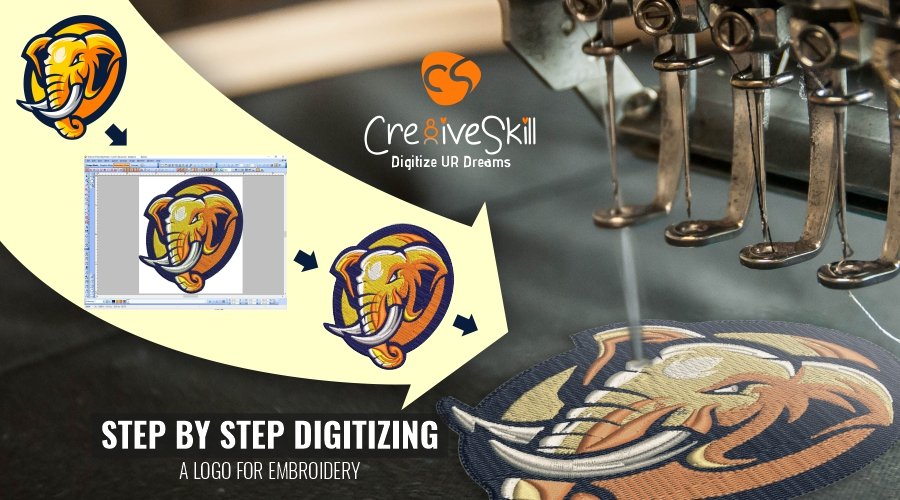Expert Digitizing for Embroidery: High-Quality Layouts
Expert Digitizing for Embroidery: High-Quality Layouts
Blog Article
Understanding the Embroidery Digitizing Process: Your Ultimate Guide
Embroidery digitizing is a meticulous craft that requires precision and competence to equate complex styles into digital formats for device embroidery. As artisans get started on this trip to grasp the needlework digitizing process, a detailed understanding of the fundamentals sets the foundation for quality.

Recognizing Embroidery Digitizing Basics
Embroidery digitizing basics form the foundation upon which elaborate styles are equated right into machine-readable layouts for specific stitching. This first step in the needlework digitizing procedure is crucial for guaranteeing that the final embroidered product is a devoted depiction of the initial layout. Recognizing embroidery digitizing basics includes comprehending key concepts such as stitch types, sew instructions, density, underlay, and draw payment.
Stitch types play an essential function in figuring out the aesthetic and textural outcome of the stitched design. By selecting the proper stitch type, whether it be satin, fill, or running stitch, digitizers can accomplish the desired effect and improve the overall high quality of the embroidery. In addition, sew direction affects the flow and measurement of the layout, while thickness figures out the spacing and coverage of the stitches.
Furthermore, rug sewing provides security to the style by protecting the material and protecting against distortion during the needlework procedure. Pull settlement is one more important factor to consider to combat the all-natural tendency of textile to contract when sewn. Mastering these needlework digitizing basics is essential for creating professional-quality stitched items.
Picking the Right Digitizing Software
Choosing the proper digitizing software application is an essential decision that considerably influences the performance and quality of the embroidery digitizing process. Digitizing for Embroidery. When selecting the appropriate digitizing software program, it is necessary to think about variables such as the intricacy of layouts you intend to create, the user-friendliness of the software, the degree of customer support provided, and the compatibility with your embroidery device
There are different digitizing software application choices readily available in the marketplace, varying from standard programs for newbies to innovative software program for specialist digitizers. Some preferred selections consist of Wilcom EmbroideryStudio, Hatch Needlework Software Application, and PulseID. These software program bundles use a wide variety of tools and functions to help you create intricate designs effortlessly.
Prior to deciding, it is suggested to check out the various software application choices with complimentary trials or demos to determine which one ideal matches your requirements. Furthermore, checking out evaluations and seeking referrals from seasoned digitizers can supply useful understandings into the strengths and weak points of each software plan (Digitizing for Embroidery). By meticulously examining your demands and contrasting the features of different digitizing software application, you can make an enlightened selection that improves your needlework digitizing workflow
Digitizing Devices and Techniques

Optimizing Style Settings for Embroidery
Mastering the complexities of click this link design settings is fundamental in attaining optimum lead to the needlework digitizing process, building upon the foundation laid by understanding digitizing devices and strategies. When enhancing style settings for needlework, it is essential to take into consideration variables such as stitch kind, density, underlay, draw settlement, and enrollment. Stitch kind option affects the overall feel and look of the style, with choices like satin, fill, and running stitches offering various structures and impacts. Density describes the spacing and density of stitches, affecting the design's coverage and longevity. Correct rug stitching provides security and stops material distortion, especially for intricate layouts or on stretchy materials. Draw compensation adjusts for textile stretch throughout stitching, guaranteeing accurate design replication. Enrollment settings align various elements of the layout accurately, keeping general layout stability. By fine-tuning these design setups, embroiderers can improve the high quality and accuracy of their embroidered productions.

Troubleshooting Common Digitizing Issues
When experiencing usual digitizing issues during the needlework process, it is important to understand the root creates and execute efficient remedies immediately. One typical issue is stitch thickness issues, where stitches may be also thick, causing the material to tighten, or also sparse, resulting in spaces in click here now the layout. Readjusting the stitch density setups in the digitizing software application can aid resolve this issue.
One more regular obstacle is string breaks during the embroidery process. This can happen because of numerous factors such as incorrect tension settings, dull needles, or utilizing low-grade thread. Guaranteeing appropriate maintenance of the embroidery maker, consisting of normal needle adjustments and stress changes, can decrease the event of string breaks.
Moreover, design enrollment mistakes can cause misaligned components within the needlework layout. Checking the design alignment in the digitizing software and making necessary adjustments prior to sewing can aid in preventing this problem. By dealing with these typical digitizing issues quickly and effectively, you can guarantee a smoother embroidery procedure and high-quality finished products.
Final Thought
To conclude, mastering the embroidery digitizing procedure needs a solid understanding of the basics, the appropriate selection of software application, and understanding of tools and strategies. Enhancing design settings and repairing typical digitizing issues are crucial action in making sure premium you could try this out embroidery results. By following these steps vigilantly, one can achieve accuracy and performance in the digitizing procedure.
Report this page